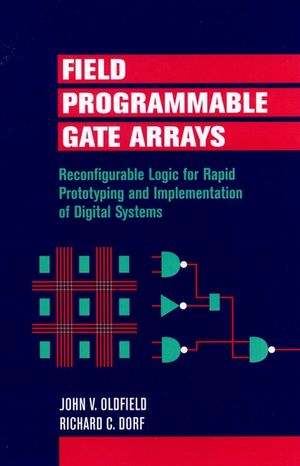Field-Programmable Gate Arrays: Reconfigurable Logic for Rapid Prototyping and Implementation of Digital SystemsISBN: 978-0-471-55665-7
Hardcover
360 pages
February 1995
 This is a Print-on-Demand title. It will be printed specifically to fill your order. Please allow an additional 10-15 days delivery time. The book is not returnable.
|
||||||
Timely, authoritative, application-oriented. an in-depthexploration of current and future uses of FPGAs in digital systemsThe development of field-programmable gate arrays (FPGAs) may wellbe the most important breakthrough for the microelectronicsindustry since the invention of the microprocessor. Using FPGAs, asystem designer working on a PC can now develop a working prototypein a few hours and change it at will in just a few minutes, ratherthan waiting weeks or months for a printed-circuit assembly or acustom integrated circuit to be built. This newfound ability tochange a system by simply altering its configuration memory is alsoleading to exciting new forms of computing, such as arrayapplications that exploit parallelism. Now in a book that functionsequally well as a working professional reference and apedagogically consistent computer engineering text, John V.Oldfield and Richard C. Dorf:
* Provide a detailed overview of FPGAs in digital systemsdesign
* Explain the underlying principles, strengths, and limitations ofmost FPGA architectures
* Supply many real-life case studies, from elementary to advancedapplications--including examples of "custom computingmachines"
* Review cutting-edge developments, including new architectures anda new field-programmable interconnect chip
* Discuss key economic and business aspects of FPGA manufacture andapplications and their role in intellectual propertyprotection
* Demonstrate ways in which FPGAs offer plausible solutions to someof the major computing problems of our day
* Provide a detailed overview of FPGAs in digital systemsdesign
* Explain the underlying principles, strengths, and limitations ofmost FPGA architectures
* Supply many real-life case studies, from elementary to advancedapplications--including examples of "custom computingmachines"
* Review cutting-edge developments, including new architectures anda new field-programmable interconnect chip
* Discuss key economic and business aspects of FPGA manufacture andapplications and their role in intellectual propertyprotection
* Demonstrate ways in which FPGAs offer plausible solutions to someof the major computing problems of our day



